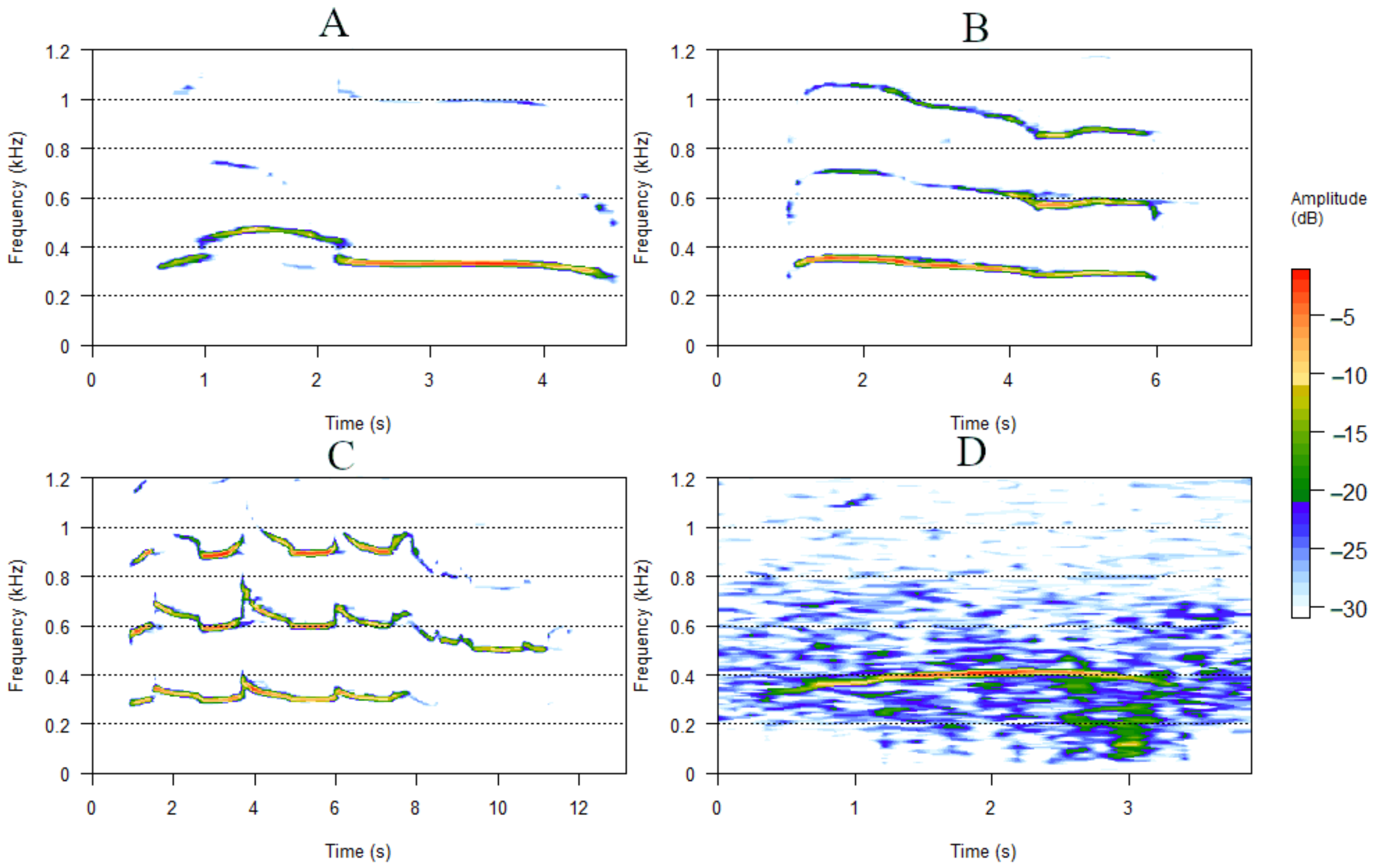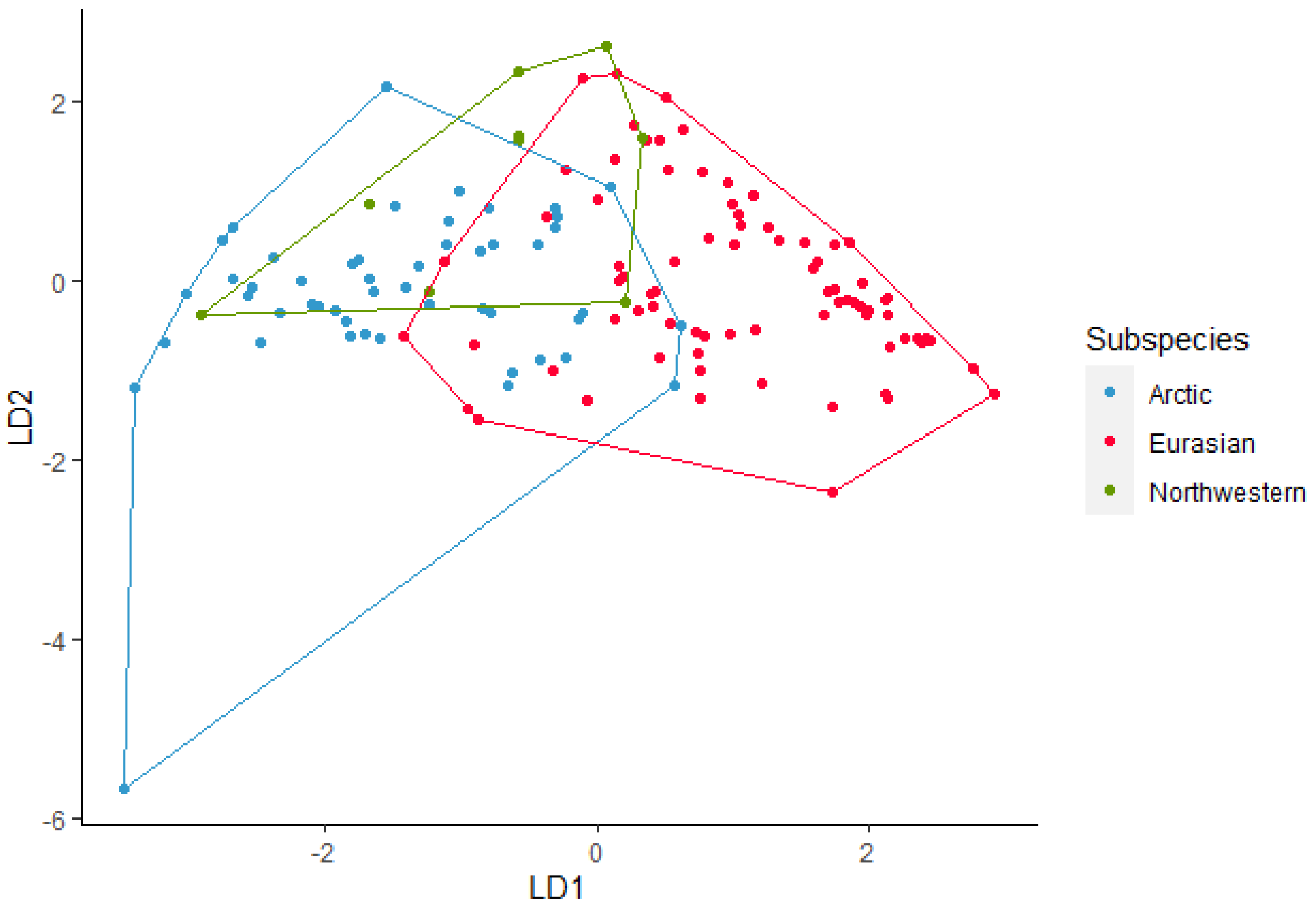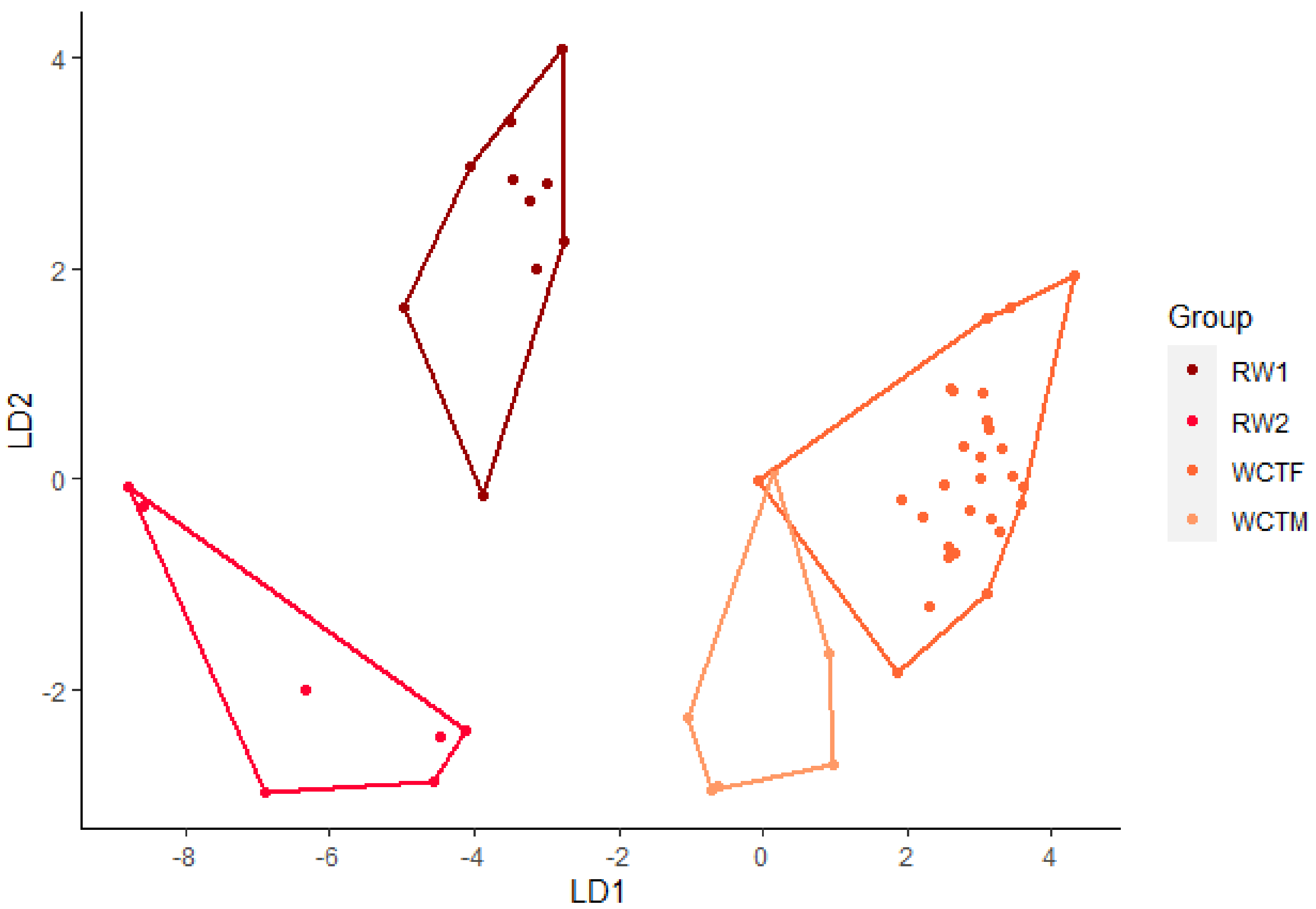Bioacoustic Detection of Wolves: Identifying Subspecies and Individuals by Howls
Simple Summary
Abstract
1. Introduction
2. Materials and Methods
2.1. Collection of Acoustic Data
2.2. Call Analysis
2.3. Processing the Data
2.4. Identification of Subspecies
2.5. Individual Identification of Wolves from Howls
3. Results
3.1. Identification of Subspecies
3.2. Individual Identification of Arctic Wolves
3.3. Individual Identification of Eurasian Wolves
4. Discussion
4.1. Identification of Subspecies
4.2. Identifying Individuals
4.3. Future Use of Acoustic Monitoring
5. Conclusions
Author Contributions
Funding
Institutional Review Board Statement
Informed Consent Statement
Data Availability Statement
Acknowledgments
Conflicts of Interest
References
- Pagh, S. Kap 3: Ulvens biologi. In Bidrag Til Opdatering Af Forvaltningsplan for Ulv [Entry for the Update of Management Plan for Wolf]; Aarhus Universitet, DCE—Nationalt Center for Miljø og Energi: Aarhus, Denmark, 2018; p. 26. [Google Scholar]
- Boitani, L. IUCN Red List of Threatened Species: Canis lupus. IUCN Red List Threat. Species. 2018. Available online: https://www.iucnredlist.org/species/3746/163508960 (accessed on 23 January 2022).
- Svensson, L.; Wabakken, P.; Maartmann, E.; Cardoso Palacios, C.; Flagstad, Ø.; Åkesson, M. Inventering av Varg Vintern 2020–2021. Bestandsovervåking av Ulv Vinteren 2020–2021 [Population Monitoring of Wolf in the Winter 2020–2021]; Norsk Institutt for Naturforskning (NINA): Trondheim, Norway, 2021; ISBN 978-82-426-4783-2. [Google Scholar]
- Olsen, K.; Sunde, P.; Vedel-Smith, C.; Hansen, M.M.; Thomsen, P.F. Statusrapport Fra Den Nationale Overvågning Af Ulv (Canis lupus) i Danmark—2. Kvartal 2021 [Progress Report from the National Monitoring of Wolf (Canis lupus) in Denmark—2. Quarter of 2021]; Aarhus Universitet, DCE—Nationalt Center for Miljø og Energi: Aarhus, Denmark, 2021; p. 19. [Google Scholar]
- Fuller, T.K.; Mech, L.D.; Cochrane, J.F. Wolf Population and Dynamics. In Wolves: Behavior, Ecology, and Conservation; Mech, L.D., Boitani, L., Eds.; University of Chicago Press: Chicago, IL, USA, 2003; pp. 161–191. ISBN 978-0-226-51697-4. [Google Scholar]
- Kirilyuk, A.; Kirilyuk, V.E.; Ke, R. Long-Distance Dispersal of Wolves in the Dauria Ecoregion. Mammal Res. 2020, 65, 639–646. [Google Scholar] [CrossRef]
- Fritts, S.H.; Stephenson, R.O.; Hayes, R.D.; Boitani, L. Wolves and Humans. In Wolves: Behavior, Ecology, and Conservation; Mech, L.D., Boitani, L., Eds.; University of Chicago Press: Chicago, IL, USA, 2003; pp. 289–316. ISBN 978-0-226-51697-4. [Google Scholar]
- Habitats Directive: Council Directive 92/43/EEC of 21 May 1992 on the Conservation of Natural Habitats and of Wild Fauna and Flora; European Union: Brussels, Belgium, 1992; pp. 7–50.
- Dbb-Wolf. Available online: https://www.dbb-wolf.de/home (accessed on 19 October 2021).
- Ulveatlas [Wolf Atlas]. Available online: https://www.ulveatlas.dk/ (accessed on 19 October 2021).
- Rovdata [Predator Data]. Available online: https://rovdata.no/Ulv/Be-standsstatus.aspx (accessed on 19 October 2021).
- Olsen, K.; Sunde, P.; Hansen, M.M.; Francis, P.; Anders, A.J. DNA-Analyser og Beskrivelse af Den Centraleuropæiske Ulvebestand, Herunder Identifikation af Ulve og Ulvehybrider [DNA-Analyses and Description of the Central European Wolf Population, Including Wolves and Wolfhybrids]; DCE—Nationalt Center for Miljø og Energi og Naturhistorisk Museum Aarhus: Aarhus, Denmark, 2019; p. 15. [Google Scholar]
- Olsen, K.; Sunde, P.; Vede-Smith, C.; Hansen, M.M.; Thomsen, P.F. Statusrapport fra den Nationale Overvågning af Ulv (Canis lupus) i Danmark—3. Kvartal 2020 [Progress Report from the National Monitoring of Wolf (Canis lupus) in Denmark—3. Quarter of 2020]; Aarhus Universitet, DCE—Nationalt Center for Miljø og Energi: Aarhus, Denmark, 2020; p. 19. [Google Scholar]
- Breitenmoser, U.; Breitenmoser-Würsten, C.; von Arx, M.; Zimmermann, F.; Ryser, A.; Angst, C.; Molinari-Jobin, A.; Molinari, P.; Linell, J.; Siegenthaler, A.; et al. Guidelines for the Monitoring of Lynx. KORA Ber. 2006, 33, 17–26. [Google Scholar]
- Sunde, P.; Olsen, K. Ulve (Canis lupus) i Danmark 2012–2017: Oversigt og Analyse af Tilgængelig Bestandsinformation [Wolves (Canis lupus) in Denmark 2012–2017: Overview and Analysis of Available Population Information]; Aarhus Universitet, DCE—Nationalt Center for Miljø og Energi: Roskilde, Denmark, 2018; pp. 15–16. [Google Scholar]
- Mankin, R.W.; Hagstrum, D.W.; Smith, M.T.; Roda, A.L.; Kairo, M.T.K. Perspective and Promise: A Century of Insect Acoustic Detection and Monitoring. Am. Entomol. 2011, 57, 30–44. [Google Scholar] [CrossRef]
- Elmeros, M.; Fjederholt, E.T.; Baagøe, H.J. Overvågning Af Flagermus På Bornholm i 2018 [Monitoring of Bats on Bornholm 2018]; DCE—Nationalt Center for Miljø og Energi: Aarhus, Denmark, 2018. [Google Scholar]
- Fjederholt, E.T.; Johansen, T.W.; Dahl Møller, J.; Christensen, M.; Baagøe, H.J. NOVANA-Overvågning Af Flagermus i 2020 [NOVANA-Monitoring of Bats in 2020]; Aarhus Universitet, DCE—Nationalt Center for Miljø og Energi: Aarhus, Denmark, 2020. [Google Scholar]
- Stastny, J.; Munk, M.; Juranek, L. Automatic Bird Species Recognition Based on Birds Vocalization. EURASIP J. Audio Speech Music Process. 2018, 2018, 19. [Google Scholar] [CrossRef]
- Moore, S.E.; Stafford, K.M.; Mellinger, D.K.; Hildebrand, J.A. Listening for Large Whales in the Offshore Waters of Alaska. BioScience 2006, 56, 49–55. [Google Scholar] [CrossRef]
- Brown, J.C.; Smaragdis, P.; Nousek-McGregor, A. Automatic Identification of Individual Killer Whales. J. Acoust. Soc. Am. 2010, 128, EL93–EL98. [Google Scholar] [CrossRef]
- Rusin, I.Y.; Volodin, I.A.; Sitnikova, E.F.; Litvinov, M.N.; Andronova, R.S.; Volodina, E.V. Roaring Dynamics in Rutting Male Red Deer Cervus elaphus from Five Russian Populations. Russ. J. Theriol. 2021, 20, 44–58. [Google Scholar] [CrossRef]
- Volodina, E.V.; Volodin, I.A.; Frey, R. Male Impala (Aepyceros melampus) Vocal Activity throughout the Rutting Period in Namibia: Daily and Hourly Patterns. Afr. J. Ecol. 2021, 60, 95–99. [Google Scholar] [CrossRef]
- Wrege, P.H.; Rowland, E.D.; Keen, S.; Shiu, Y. Acoustic Monitoring for Conservation in Tropical Forests: Examples from Forest Elephants. Methods Ecol. Evol. 2017, 8, 1292–1301. [Google Scholar] [CrossRef]
- Papin, M.; Pichenot, J.; Guérold, F.; Germain, E. Acoustic Localization at Large Scales: A Promising Method for Grey Wolf Monitoring. Front. Zool. 2018, 15, 11. [Google Scholar] [CrossRef]
- Joslin, P.W.B. Movements and Home Sites of Timber Wolves in Algonquin Park. Am. Zool. 1967, 7, 279–288. [Google Scholar] [CrossRef]
- Root-Gutteridge, H.; Bencsik, M.; Chebli, M.; Gentle, L.K.; Terrell-Nield, C.; Bourit, A.; Yarnell, R.W. Identifying Individual Wild Eastern Grey Wolves (Canis lupus lycaon) Using Fundamental Frequency and Amplitude of Howls. Bioacoustics 2014, 23, 55–66. [Google Scholar] [CrossRef]
- Suter, S.M.; Giordano, M.; Nietlispach, S.; Apollonio, M.; Passilongo, D. Non-Invasive Acoustic Detection of Wolves. Bioacoustics 2017, 26, 237–248. [Google Scholar] [CrossRef]
- Whytock, R.C.; Christie, J. Solo: An Open Source, Customizable and Inexpensive Audio Recorder for Bioacoustic Research. Methods Ecol. Evol. 2017, 8, 308–312. [Google Scholar] [CrossRef]
- Garland, L.; Crosby, A.; Hedley, R.; Boutin, S.; Bayne, E. Acoustic vs. Photographic Monitoring of Gray Wolves (Canis lupus): A Methodological Comparison of Two Passive Monitoring Techniques. Can. J. Zool. 2020, 98, 219–228. [Google Scholar] [CrossRef]
- Passilongo, D.; Mattioli, L.; Bassi, E.; Szabó, L.; Apollonio, M. Visualizing Sound: Counting Wolves by Using a Spectral View of the Chorus Howling. Front. Zool. 2015, 12, 22. [Google Scholar] [CrossRef]
- Hennelly, L.; Habib, B.; Root-Gutteridge, H.; Palacios, V.; Passilongo, D. Howl Variation across Himalayan, North African, Indian, and Holarctic Wolf Clades: Tracing Divergence in the World’s Oldest Wolf Lineages Using Acoustics. Curr. Zool. 2017, 63, 341–348. [Google Scholar] [CrossRef][Green Version]
- Harrington, F.H.; Mech, L.D. Wolf Howling and Its Role in Territory Maintenance. Behaviour 1979, 68, 207–249. [Google Scholar] [CrossRef]
- Mitchell, B.R.; Makagon, M.M.; Jaeger, M.M.; Barrett, R.H. Information Content of Coyote Barks and Howls. Bioacoustics 2006, 15, 289–314. [Google Scholar] [CrossRef]
- Nowak, S.; Jędrzejewski, W.; Schmidt, K.; Theuerkauf, J.; Mysłajek, R.W.; Jędrzejewska, B. Howling Activity of Free-Ranging Wolves (Canis lupus) in the Białowieża Primeval Forest and the Western Beskidy Mountains (Poland). J. Ethol. 2007, 25, 231–237. [Google Scholar] [CrossRef]
- Palacios, V.; Font, E.; Márquez, R. Iberian Wolf Howls: Acoustic Structure, Individual Variation, and a Comparison with North American Populations. J. Mammal. 2007, 88, 606–613. [Google Scholar] [CrossRef]
- Theberge, J.B.; False, J.B. Howling as a Means of Communication in Timber Wolves. Am. Zool. 1967, 7, 331–338. [Google Scholar] [CrossRef]
- Tooze, Z.J.; Harrington, F.H.; Fentress, J.C. Individually Distinct Vocalizations in Timber Wolves, Canis lupus. Anim. Behav. 1990, 40, 723–730. [Google Scholar] [CrossRef]
- Sadhukhan, S.; Root-Gutteridge, H.; Habib, B. Identifying Unknown Indian Wolves by Their Distinctive Howls: Its Potential as a Non-Invasive Survey Method. Sci. Rep. 2021, 11, 7309. [Google Scholar] [CrossRef]
- Root-Gutteridge, H.; Bencsik, M.; Chebli, M.; Gentle, L.K.; Terrell-Nield, C.; Bourit, A.; Yarnell, R.W. Improving Individual Identification in Captive Eastern Grey Wolves (Canis lupus lycaon) Using the Time Course of Howl Amplitudes. Bioacoustics 2014, 23, 39–53. [Google Scholar] [CrossRef]
- Kershenbaum, A.; Root-Gutteridge, H.; Habib, B.; Koler-Matznick, J.; Mitchell, B.; Palacios, V.; Waller, S. Disentangling Canid Howls across Multiple Species and Subspecies: Structure in a Complex Communication Channel. Behav. Process. 2016, 124, 149–157. [Google Scholar] [CrossRef]
- Zaccaroni, M.; Passilongo, D.; Buccianti, A.; Dessì-Fulgheri, F.; Facchini, C.; Gazzola, A.; Maggini, I.; Apollonio, M. Group Specific Vocal Signature in Free-Ranging Wolf Packs. Ethol. Ecol. Evol. 2012, 24, 322–331. [Google Scholar] [CrossRef]
- Randler, C.; Kalb, N. Distance and Size Matters: A Comparison of Six Wildlife Camera Traps and Their Usefulness for Wild Birds. Ecol. Evol. 2018, 8, 7151–7163. [Google Scholar] [CrossRef]
- Zimen, E. On the Regulation of Pack Size in Wolves. Z. Tierphysiol. 2010, 40, 300–341. [Google Scholar] [CrossRef]
- Walker, K.M.; Gonzalez, R.; Kang, J.Z.; McDermott, J.H.; King, A.J. Across-Species Differences in Pitch Perception Are Consistent with Differences in Cochlear Filtering. eLife 2019, 8, e41626. [Google Scholar] [CrossRef]
- De Cheveigné, A.; Kawahara, H. YIN, a Fundamental Frequency Estimator for Speech and Music. J. Acoust. Soc. Am. 2002, 111, 1917–1930. [Google Scholar] [CrossRef] [PubMed]
- Audacity Team. Audacity®. Version 2.4.2. Available online: http://audacityteam.org/ (accessed on 16 November 2020).
- Boersma, P.; Weenink, D. Praat: Doing Phonetics by Computer [Computer Program]. Available online: http://www.praat.org/ (accessed on 16 February 2021).
- Mathworks Inc. MATLAB, Version 9.9.0.1592791 (R2020b) Update 5; Mathworks: Natick, MA, USA, 2020. [Google Scholar]
- Watson, S.K.; Townsend, S.W.; Range, F. Wolf Howls Encode Both Sender- and Context-Specific Information. Anim. Behav. 2018, 145, 59–66. [Google Scholar] [CrossRef]
- Sueur, J. Sound Analysis and Synthesis with R, 1st ed.; Use R! Springer International Publishing: Cham, Switzerland, 2018; ISBN 978-3-319-77647-7. [Google Scholar]
- Rstudio Team. RStudio: Integrated Development Environment for R; Rstudio: Boston, MA, USA, 2021. [Google Scholar]
- Sueur, J.; Aubin, T.; Simonis, C. Seewave, a Free Modular Tool for Sound Analysis and Synthesis. Bioacoustics 2008, 18, 213–226. [Google Scholar] [CrossRef]
- Rice, W.R. Analyzing Tables of Statistical Tests. Evolution 1989, 43, 223–225. [Google Scholar] [CrossRef]
- Hull, C.; McCombe, C.; Dassow, A. Acoustic Identification of Wild Gray Wolves, Canis lupus, Using Low Quality Recordings. Am. J. Undergrad. Res. 2020, 16, 41–49. [Google Scholar] [CrossRef]
- Ciira, W.M. Cost Effective Acoustic Monitoring of Bird Species. In Proceedings of the Interspeech, San Francisco, CA, USA, 8 September 2016; pp. 2617–2620. [Google Scholar]
- Buxton, R.T.; Lendrum, P.E.; Crooks, K.R.; Wittemyer, G. Pairing Camera Traps and Acoustic Recorders to Monitor the Ecological Impact of Human Disturbance. Glob. Ecol. Conserv. 2018, 16, e00493. [Google Scholar] [CrossRef]
- Gaynor, K.M.; Hojnowski, C.E.; Carter, N.H.; Brashares, J.S. The Influence of Human Disturbance on Wildlife Nocturnality. Science 2018, 360, 1232–1235. [Google Scholar] [CrossRef]




| Wolf | Source | Subspecies | Scientific Name | Status | No. of Howls |
|---|---|---|---|---|---|
| GW1 | Givskud Zoo, Denmark | Northwestern | Canis lupus occidentalis | Captive | 2 |
| GW2 | Givskud Zoo, Denmark | Northwestern | Canis lupus occidentalis | Captive | 7 |
| GW3 | Givskud Zoo, Denmark | Northwestern | Canis lupus occidentalis | Captive | 2 |
| SK1 | Skandinavisk Dyrepark, Denmark | Eurasian | Canis lupus lupus | Captive | 6 |
| SK2 | Skandinavisk Dyrepark, Denmark | Eurasian | Canis lupus lupus | Captive | 5 |
| Ulf | In the wild close to Ulfborg, Central Jutland, Denmark | Eurasian | Canis lupus lupus | Wild | 13 |
| BLS004 | UK Wolf Conservation Trust | Eurasian | Canis lupus lupus | Captive | 4 |
| BLS010 | British Library Sound Archive | Eurasian | Canis lupus lupus | Captive | 34 |
| BLS011 | British Library Sound Archive | Eurasian | Canis lupus lupus | Captive | 7 |
| BLS026 | Macaulay Sound Archive | Eurasian | Canis lupus lupus | Captive | 6 |
| BLS028 | Poropets, Russia | Eurasian | Canis lupus lupus | Captive | 18 |
| BLS029 | UK Wolf Conservation | Eurasian | Canis lupus lupus | Captive | 4 |
| WCTM | UK Wolf Conservation Trust | Arctic | Canis lupus arctos | Captive | 7 |
| WCTF | UK Wolf Conservation Trust | Arctic | Canis lupus arctos | Captive | 35 |
| RW1 | Ree Park Safari, Denmark | Arctic | Canis lupus arctos | Captive | 12 |
| RW2 | Ree Park Safari, Denmark | Arctic | Canis lupus arctos | Captive | 8 |
| Variable | Definition | Extracted from |
|---|---|---|
| Meanf0 a,b,c | Mean of the distribution of the fundamental frequency in Hz | Praat |
| Minf0 a,b,c | Minimum of fundamental frequency in Hz | Praat |
| Posminf0 a | Position of minimum frequency (time of min/duration) | Praat |
| Maxf0 a,b | Maximum frequency in Hz | Praat |
| Posmaxf0 a | Position of maximum frequency (time of max/duration) | Praat |
| Sd | Standard deviation of the mean fundamental frequency Hz | Praat |
| Cofv a,b | Coefficient of frequency variation ((sd/Meanf0) × 100) | Praat |
| Slope c | The mean absolute slope of the distribution of f0 | MATLAB |
| Cofm a,b | Coefficient of frequency modulation Σ|f(t) − f(t + 1)|/(n − 1)/Meanf0 × 100 | MATLAB |
| Range b | Range of the frequency (Maxf0 − Minf0) | Praat |
| Q25 | 25% of the distribution of the fundamental frequency in Hz | Praat |
| Q75 | 75% of the distribution of the fundamental frequency in Hz | Praat |
| IQR | Interquartile range of f0 (Q75 − Q25) | Praat |
| Startf0 c | Start of the fundamental frequency in Hz | MATLAB |
| Endf0 a,b,c | End of the fundamental frequency in Hz | MATLAB |
| Duration a,b,c | Duration of the howl in seconds | MATLAB |
| Removed Variable | Correlated with | |
|---|---|---|
| Subspecies | Meanf0 | Maxf0, Endf0 |
| Range | Maxf0, Sd | |
| Posminf0 | Posmaxf0 | |
| Arctic wolves | Range | Maxf0, Sd |
| Posminf0 | Posmaxf0 | |
| Cofv | ||
| Slope | Endf0 | |
| Range | Maxf0, Sd | |
| IQR | Startf0 | |
| Eurasian wolves | Meanf0 | Minf0, Maxf0, Endf0 |
| Posminf0 | Minf0 | |
| Cofv | Maxf0 | |
| Slope | ||
| Range | Startf0, Endf0 | |
| IQR | Minf0 |
| F | p | DF | |
|---|---|---|---|
| Arctic-Eurasian | 23.77 | <0.001 # | 9 |
| Arctic-Northwestern | 2.9 | <0.01 # | 9 |
| Eurasian-Northwestern | 10 | <0.001 # | 9 |
| F | p | DF | |
|---|---|---|---|
| RW1-RW2 | 33.2 | <0.001 # | 8 |
| RW1-WCTM | 37.52 | <0.001 # | 8 |
| RW1-WTCF | 93.87 | <0.001 # | 8 |
| RW2-WCTM | 9.68 | <0.01 # | 8 |
| RW2-WCTF | 41.74 | <0.001 # | 8 |
| WCTM-WCTF | 8.2 | <0.01 # | 8 |
| F | p | DF | |
|---|---|---|---|
| BLS010-BLS011 | 8.05 | <0.001 # | 7 |
| BLS010-BLS026 | 13.91 | <0.001 # | 7 |
| BLS010-BLS028 | 62.04 | <0.001 # | 7 |
| BLS010-SK1 | 58.31 | <0.001 # | 7 |
| BLS010-ULF | 169.04 | <0.001 # | 7 |
| BLS011-BLS026 | 1.56 | n.s. | 7 |
| BLS011-BLS028 | 9.21 | <0.001 # | 7 |
| BLS011-SK1 | 23.07 | <0.01 # | 7 |
| BLS011-ULF | 32.85 | <0.001 # | 7 |
| BLS026-BLS028 | 10.2 | <0.001 # | 7 |
| BLS026-SK1 | 9.61 | <0.05 | 7 |
| BLS026-ULF | 34.13 | <0.001 # | 7 |
| BLS028-SK1 | 17.44 | <0.001 # | 7 |
| BLS028-ULF | 37.4 | <0.001 # | 7 |
| SK1-ULF | 13.16 | <0.001 # | 7 |
Publisher’s Note: MDPI stays neutral with regard to jurisdictional claims in published maps and institutional affiliations. |
© 2022 by the authors. Licensee MDPI, Basel, Switzerland. This article is an open access article distributed under the terms and conditions of the Creative Commons Attribution (CC BY) license (https://creativecommons.org/licenses/by/4.0/).
Share and Cite
Larsen, H.L.; Pertoldi, C.; Madsen, N.; Randi, E.; Stronen, A.V.; Root-Gutteridge, H.; Pagh, S. Bioacoustic Detection of Wolves: Identifying Subspecies and Individuals by Howls. Animals 2022, 12, 631. https://doi.org/10.3390/ani12050631
Larsen HL, Pertoldi C, Madsen N, Randi E, Stronen AV, Root-Gutteridge H, Pagh S. Bioacoustic Detection of Wolves: Identifying Subspecies and Individuals by Howls. Animals. 2022; 12(5):631. https://doi.org/10.3390/ani12050631
Chicago/Turabian StyleLarsen, Hanne Lyngholm, Cino Pertoldi, Niels Madsen, Ettore Randi, Astrid Vik Stronen, Holly Root-Gutteridge, and Sussie Pagh. 2022. "Bioacoustic Detection of Wolves: Identifying Subspecies and Individuals by Howls" Animals 12, no. 5: 631. https://doi.org/10.3390/ani12050631
APA StyleLarsen, H. L., Pertoldi, C., Madsen, N., Randi, E., Stronen, A. V., Root-Gutteridge, H., & Pagh, S. (2022). Bioacoustic Detection of Wolves: Identifying Subspecies and Individuals by Howls. Animals, 12(5), 631. https://doi.org/10.3390/ani12050631









